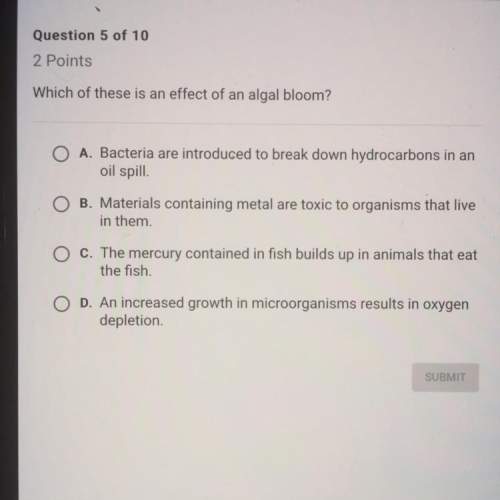
Biology, 14.02.2020 23:07, arinegrete2003
Laboratory studies indicate a client's blood glucose level is 185 mg/dl. Two hours have passed since the client ate breakfast. Which test would yield the most conclusive diagnostic information about the client's glucose use?

Answers: 2
Other questions on the subject: Biology

Biology, 21.06.2019 22:00, kmh05
Fan egg cell containing the (n+1) number of chromosomes combines with a sperm cell containing the (n) number of chromosomes, what is the result of this union? a) all future somatic cells of the organism will contain the (2n + 1) number of chromosomes. b) all future somatic cells of the organism will contain the (2n - 1) number of chromosomes. c) only certain somatic cells of the organism will contain the (2n + 1) number of chromosomes. d) all future somatic cells of the organism will contain the normal diploid number of chromosomes.
Answers: 2


Biology, 22.06.2019 04:00, zegangke1651
Will mark brainliest i only need the ! 1.use ten beads and a centromere of one color to construct the long chromosome. use ten beads and a centromere of a second color to construct the second chromosome in the long pair. make a drawing of the chromosomes in the space below. 2. for the second pair of chromosomes, use only five beads. 3. now model the replication of the chromosomes. make a drawing of your model in the space below. part b: meiosis i during meiosis i, the cell divides into two diploid daughter cells. 4. pair up the chromosomes to form tetrads. use the longer tetrad to model crossing-over. make a drawing of the tetrads in the space below. 5. line up the tetrads across the center of your “cell.” then model what happens to the chromosomes during anaphase i. 6. divide the cell into two daughter cells. use the space below to make a drawing of the result. part c: meiosis ii during meiosis ii, the daughter cells divide again. 7. line up the chromosomes at the center of the first cell, one above the other. separate the chromatids in each chromosome and move them to opposite sides of the cell. 8. repeat step 7 for the second cell. 9. divide each cell into two daughter cells. use the space below to make a drawing of the four haploid cells
Answers: 1

Biology, 22.06.2019 08:00, kajjumiaialome
Vaccines are weakened forms of disease causing microorganisms, which are given to patients to prevent disease. after the vaccine is administered, the immune system responds by creating a(n) to recognize the a.) antibody, antibiotic b.) antigen, antibody c.)antibiotic, antibody d.)antibody, antigen
Answers: 1
Do you know the correct answer?
Laboratory studies indicate a client's blood glucose level is 185 mg/dl. Two hours have passed since...
Questions in other subjects:




English, 25.08.2019 11:10

Chemistry, 25.08.2019 11:10



History, 25.08.2019 11:10


Mathematics, 25.08.2019 11:10







